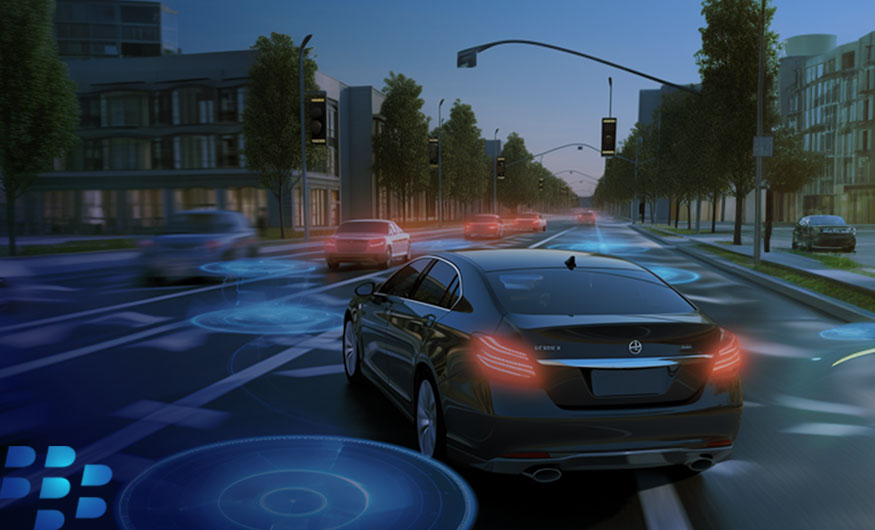Automatic Emergency Braking May Become Mandatory in the U.S.
Millions of rear-end car crashes occur each year in the U.S., killing nearly 2,000 people on average, according to the U.S. Department of Transportation. Failure to stop also kills more than 6,000 pedestrians and injures approximately 75,000 annually. What if a new safety feature, controlled by software, could protect most of these lives, lower insurance claims, and increase the odds that everyone gets to their destination safely?
This is not merely a rhetorical question. Some of the newest vehicles on the road today already have AEB (automatic emergency braking) that engages the vehicle’s brakes if the driver has not done so, or applies more force to supplement the driver's braking when necessary. Including this feature has been a voluntary effort in the United States to date, but on May 31, 2023, the U.S. Department of Transportation (DOT) National Highway Traffic Safety Administration (NHTSA) proposed new rules that would make AEB mandatory on all new passenger cars and light trucks.
If the new rules are adopted in the U.S., the impact on automotive OEMs will be significant. The European Union (EU) passed similar regulations in 2019; however, proposed U.S. regulations go a step further by requiring AEB systems to be able to identify pedestrians — even at night.
How Software-Defined AEB Saves Lives
The new NHTSA rules would require AEB and pedestrian AEB (PAEB) systems on all passenger cars and light trucks. Additionally, all cars must be able to automatically stop from a top speed of 62 miles per hour, to avoid contact with a vehicle in front of them. According to the U.S. DOT, this change is the next evolution of vehicle safety:
“Just as lifesaving innovations from previous generations like seat belts and airbags have helped improve safety, requiring automatic emergency braking on cars and trucks would keep all of us safer on our roads,” U.S. Secretary of Transportation Pete Buttigieg said in a prepared statement.
Under NHSTA’s Notice of Proposed Rulemaking (NPRM), the new rules would require every vehicle manufacturer to comply. This means OEMs should develop a streamlined approach to implementing these types of compliance-driven capabilities.
How Do AEB Systems Work?
Automatic emergency braking is an intelligent, sensor-based, and software-defined system that assists drivers in potential collision situations. In the event of an imminent collision, the AEB system intervenes autonomously to apply the vehicle's brakes, reducing the severity of the impact or avoiding it altogether.
A forward-facing radar sensor is one of the key components of an AEB system. Using radio waves, the radar continuously scans the road ahead, measuring the distance, speed, and direction of objects in its path. By analyzing the Doppler effect (changes in the frequency of the reflected radio waves), the radar can determine if an object poses a potential collision risk. A forward-facing camera also captures real-time images of the road and its surroundings. Advanced image recognition algorithms in the embedded software can then identify various objects, including vehicles, pedestrians, cyclists, and traffic signs.
Lidar (light detection and ranging) technology is also making its way into AEB systems. Lidar sensors use laser pulses to create a three-dimensional map of the vehicle's surroundings, providing precise distance measurements and object-recognition capabilities.
Finally, ultrasonic sensors are typically positioned around the vehicle's perimeter, including the front and rear bumpers. These sensors emit high-frequency sound waves and measure the time it takes for them to bounce back after hitting an object. By calculating the time delay, an AEB system can determine the distance between the vehicle and potential obstacles. Ultrasonic sensors are already common for parking assistance systems.
The Need for a Safe, Reliable, High-Performance Operating System
When a car is packed with sensors that continuously gather data, it needs high-performance computing power to analyze that data and make real-world decisions, such as when to apply the brakes in an emergency situation. The comprehensive dataset enables the system to create an accurate and dynamic picture of the surroundings, but not without a robust real-time operating system (RTOS) to harness it.
Real-time operating systems have been developed to meet the demands of next-generation systems, which include high-performance silicon, in order to bring supercomputing power to IoT (Internet of Things) devices and the automotive industry. Thanks to its next-generation microkernel architecture, BlackBerry® QNX® Software Development Platform (SDP) 8.0 is one such RTOS, delivering high performance, superior scalability, low latency, and security.
Software-defined vehicles also require functionality to be consolidated — reducing wiring, weight, and ultimately cost — by using central computing or zonal architectures that host mixed-criticality and high-performance software within a single central computing domain. Complexity is an inherent downside of mixed-criticality systems. However, technical solutions, such as the functional-safety-certified hypervisors offered by BlackBerry QNX, are designed to simplify by partitioning the software into multiple ASIL (automotive safety integrity level) designations, each contained in its own protected, “virtualized” space.
BlackBerry QNX SDP 8.0 also enables cost-effective development processes that streamline development with standards-based tools and cloud enablement. Its scaling capabilities additionally allow development teams to create software that can be used across multiple products and systems, including AEB solutions.
Supporting SDV Features of the Future
As the automotive industry continues to embrace technological advancements, AEB systems are poised to become increasingly sophisticated, further enhancing road safety. Many organizations in the industry are driving this innovation together with software partners such as BlackBerry, and regulators are paying attention.
Already used in more than 235 million vehicles on the road today — including many that already meet new AEB standards, BlackBerry QNX software is well-positioned to support future advanced safety features looming on the horizon.
For similar articles and news delivered straight to your inbox, subscribe to the BlackBerry Blog.
About David McCourt
David McCourt is Content Marketing Manager at QNX.

